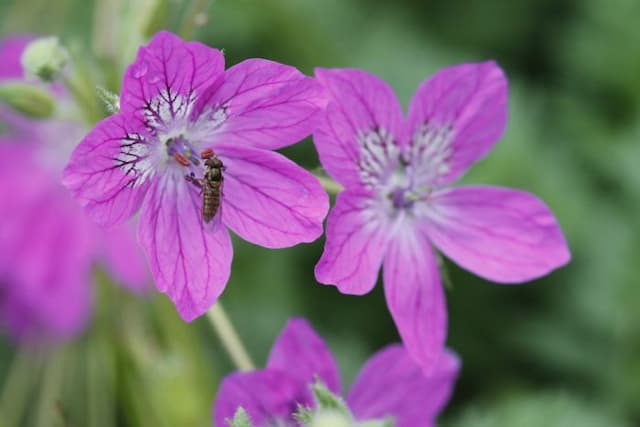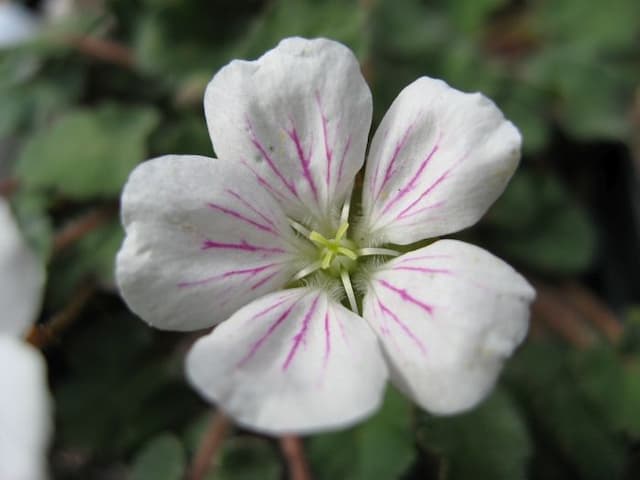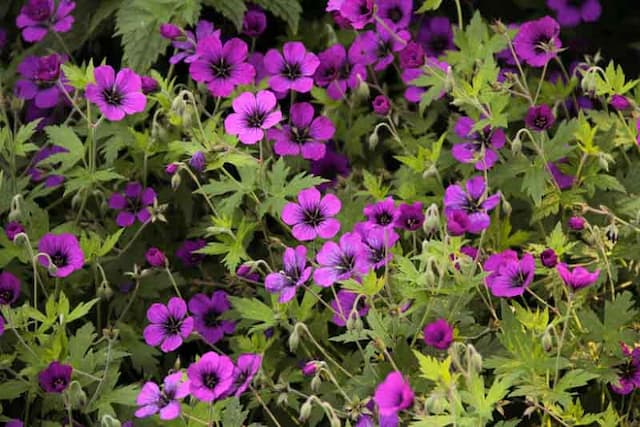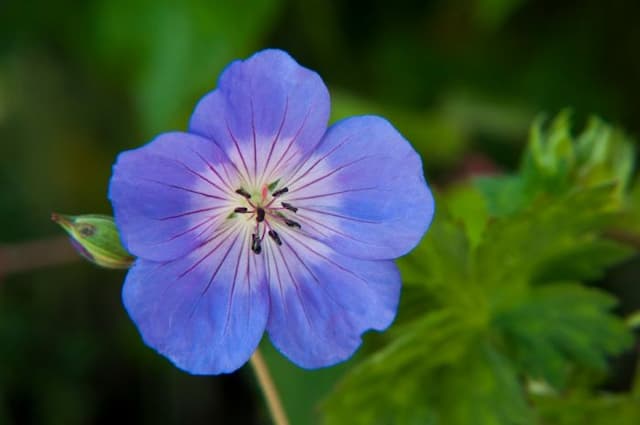Pelargonium 'Olga Shipstone' Pelargonium 'Olga Shipstone' (Sc)

ABOUT
'Olga Shipston' is a compact, bushy perennial with small, evergreen leavesthat have aslightly fruity scent and clusters of small white flowers that are borne from late spring into autumn
About this plant
 Names
NamesFamily
Geraniaceae
Synonyms
Olga Shipstone Geranium, Olga Shipstone Pelargonium
Common names
Pelargonium 'Olga Shipstone'
 Characteristics
CharacteristicsLife cycle
Perennials
Foliage type
Evergreen
Color of leaves
Varies
Flower color
Varies
Height
1-2 feet (30-60 cm)
Spread
1-2 feet (30-60 cm)
Plant type
Herb
Hardiness zones
10
Native area
South Africa
Benefits
 General Benefits
General Benefits- Easy to Grow: The plant is known for its hardiness and minimal care requirements, making it suitable for both novice and experienced gardeners.
- Decorative Appeal: With its vibrant flowers and attractive foliage, it adds color and aesthetic value to gardens, balconies, and indoor spaces.
- Drought Tolerant: As a succulent, it's capable of withstanding periods of low water availability, suitable for water-wise gardens.
- Pest Resistance: It exhibits a natural resistance to common garden pests, reducing the need for chemical pesticides.
- Adaptability: The plant can thrive in a variety of soil types and weather conditions, making it a versatile choice for many environments.
- Long Blooming Period: It produces flowers for an extended period, often from spring to fall, providing long-lasting color.
- Container Friendly: It does well in pots and containers, making it an excellent option for those with limited gardening space.
- Attracts Pollinators: The flowers can attract beneficial insects like bees and butterflies, promoting biodiversity.
- Low Maintenance: It requires minimal pruning and feeding, making it a low-maintenance option for busy gardeners.
 Medical Properties
Medical PropertiesThis plant is not used for medical purposes.
 Air-purifying Qualities
Air-purifying QualitiesThis plant is not specifically known for air purifying qualities.
 Other Uses
Other Uses- Pelargonium 'Olga Shipstone', commonly known as scented geranium, can be used in perfumery for its fragrant leaves, creating unique and pleasant aromas.
- The leaves of a scented geranium can be infused in sugar, imparting a delicate flavor, perfect for baking or sweetening teas.
- Fresh or dried scented geranium leaves can be added to potpourri, contributing to a mix of scents for a fresh smelling home.
- A scented geranium can be planted among other plants in the garden as a natural way to deter certain pests with its strong fragrance.
- The essential oils from scented geranium leaves can be used in homemade candles or diffusers to naturally scent a room.
- Scented geranium leaves can be used to impart a subtle flavor to jellies or preserves, offering a unique twist to traditional recipes.
- When placed in drawers or closets, the scented geranium’s leaves can act as a natural moth repellent while clothing gains a faintly pleasant aroma.
- Leaves of the scented geranium can be used to make a flavored syrup that can be added to cocktails, sodas, or desserts for an interesting flavor profile.
- The petals of scented geraniums are edible and can be used as a colorful, fragrant garnish on salads or desserts.
- Scented geraniums can be used in dyeing fabric or paper, as some species of the plant can produce a range of pigments depending on mordants used.
Interesting Facts
 Feng Shui
Feng ShuiThe Geranium is not used in Feng Shui practice.
 Zodiac Sign Compitability
Zodiac Sign CompitabilityThe Geranium is not used in astrology practice.
 Plant Symbolism
Plant Symbolism- Comfort and Healing: Often associated with wellness and recovery, Pelargonium 'Olga Shipstone' is believed to bring comfort to those who are ill or healing from physical or emotional setbacks.
- Protection: In some cultures, it is thought to ward off evil spirits and negative energies, providing a protective barrier around one's living space.
- Friendship: The inviting fragrance and delicate appearance may represent the warmth and open-hearted nature of friendship.
- Femininity: With its soft floral notes and graceful appearance, this plant is sometimes associated with the beauty and gentleness of femininity.
- Emotional Balance: Its presence in the home is thought to promote emotional stability and create a calming atmosphere.
 Water
WaterGeraniums such as 'Olga Shipstone' prefer their soil to be kept evenly moist but not waterlogged. During the growing season, water the plant when the top inch of soil feels dry to the touch, which typically means watering once a week with about 6-8 ounces of water for a standard 6-inch pot. In winter, reduce watering to every other week, ensuring you provide slightly less water, about 4-6 ounces, as the plant's growth slows down. Always avoid letting the pot sit in standing water, and make sure the container has good drainage to prevent root rot.
 Light
LightGeraniums thrive in bright, indirect sunlight. Place your 'Olga Shipstone' near a south or west-facing window where it can receive plenty of light without the harsh direct rays of the sun. If the light is too intense, use a sheer curtain to diffuse it. These light conditions will encourage abundant flowering and healthy foliage growth.
 Temperature
TemperatureGeraniums prefer moderate temperatures and will flourish when kept in an environment between 65 and 75 degrees Fahrenheit. They can tolerate a minimum temperature of about 55 degrees Fahrenheit during the night but should not be exposed to temperatures below 50 degrees Fahrenheit as they are not frost-tolerant. The ideal temperature range ensures vibrant growth and flowering.
 Pruning
PruningPruning your Geranium 'Olga Shipstone' is crucial for maintaining a bushy, compact shape and encouraging more blooms. Pinch off any leggy stems and deadhead spent flowers regularly to promote new growth. The best time for a more extensive pruning is in early spring or just before the growing season begins. Pruning can be done several times throughout the growing season if necessary.
 Cleaning
CleaningAs needed
 Soil
SoilThe best soil mix for the geranium (Pelargonium 'Olga Shipstone') is well-draining potting soil amended with perlite or sand to enhance drainage. The soil pH should ideally be in the range of 6.0 to 7.0.
 Repotting
RepottingGeraniums (Pelargonium 'Olga Shipstone') should be repotted every 1 to 2 years, or when they outgrow their current container.
 Humidity & Misting
Humidity & MistingGeraniums (Pelargonium 'Olga Shipstone') prefer moderate humidity levels, around 40-60%, and do well in typical indoor environments.
 Suitable locations
Suitable locationsIndoor
Place in bright, indirect light and water weekly.
Outdoor
Plant in full sun to partial shade, and ensure soil drains well.
Hardiness zone
10-11 USDA
 Life cycle
Life cyclePelargonium 'Olga Shipstone', commonly known as Scented Geranium, begins its life when seeds are sown into well-drained soil and germinate, which usually occurs in warm, temperate conditions. The seedlings then develop true leaves and establish a root system, gradually maturing into vegetative plants with characteristic fragrant foliage. As the plants grow, they enter a phase of budding, where flower stalks emerge and buds form, typically in response to lengthening daylight. The buds bloom into clusters of small flowers, varying in color, and after pollination, which can be facilitated by insects or wind, the flowers develop into fruit containing seeds, thus completing the reproductive stage. The plants can also be propagated vegetatively through cuttings, where sections of the stem are rooted to form new plants that are genetically identical to the parent. With adequate care, including proper sunlight, water, and fertilization, Scented Geraniums can live for several years, repeating the flowering and seeding cycle annually or as conditions permit.
 Propogation
PropogationPropogation time
Spring-Fall
Propogation: The Pelargonium 'Olga Shipstone', commonly known as a scented geranium, is most effectively propagated through stem cuttings. This method is popular because it reliably produces an exact clone of the parent plant. The best time for taking cuttings is in late spring to early summer when the plant is actively growing. For propagation, select a healthy, non-flowering stem and cut a piece about 4 to 6 inches (10 to 15 centimeters) in length. Remove the leaves from the lower half of the cutting, and dip the cut end into a rooting hormone powder to encourage root development. Then, plant the cutting in a pot filled with a well-draining soil mix and cover with a plastic bag to maintain humidity. Place the pot in indirect light, and keep the soil moist but not waterlogged. Roots typically develop within a few weeks, after which the plastic can be removed, and the new plant gradually acclimatized to less humid conditions.







![Cranesbill [Rothbury Gem]](/_next/image?url=https%3A%2F%2Fplants-admin.emdemapps.com%2Fimages%2Fplants%2F%2Fimages%2F604b6243984c2.png&w=640&q=75)

